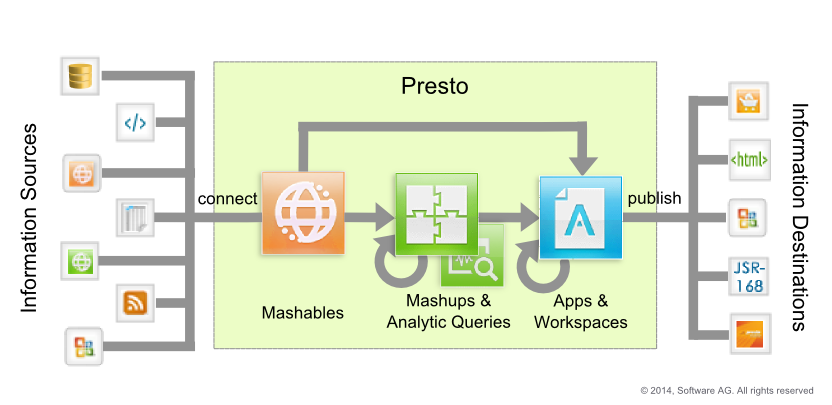MashZone NextGen Artifacts: A 'Black Box' View of the Flow of Information
MashZone NextGen directly hosts apps and mashups and acts as a virtual host for mashable information sources. These are the artifacts that users work with in MashZone NextGen.
Information Sources
Information sources you can access through MashZone NextGen includes databases, applications or common documents, such as spreadsheets. Information sources may be internal to your organization or external.
Information sources can be accessed by many different protocols, such as the SOAP, REST, RSS or Atom protocols. They can also be file-based in Excel, CSV or XML formats. Or SharePoint lists and searches. They can be databases or datasets stored in memory.
They return information, their results, in many different forms.
Note: | Access to some mashable information sources requires MashZone NextGen Add-Ons. Some MashZone NextGen Add-Ons also provide users with access to results from MashZone NextGen mashables or mashups. |

Mashables
Users create mashables in MashZone NextGen to quickly and securely connect to different information sources and retrieve data as needed. Mashable artifacts define the connection and security configuration and the specific operations or queries needed to retrieve data from databases, applications or documents.
MashZone NextGen simplifies and normalizes results from different information sources for easy access. Users access and run mashables using a single, simple interface without having to manage or understand all the complexities of communication, security and different protocols. MashZone NextGen returns mashable results in either XML or JSON formats.

Mashups
In MashZone NextGen, mashups simplify, combine or transform data to produce just the information you need. Users create mashups that combine or transform results from mashables, databases or from other mashups in useful ways.
Mashups can also simply wrap applications to make them accessible in MashZone NextGen. Both mashables and mashups use seamless access policies for governance over all information sources.
Mashups can also work with very large amounts of information, sometimes called 'big data.' Large datasets require a MashZone NextGen Add-On that uses streaming and analytic queries.

Analytic Queries
Analytic queries work within mashups to retrieve, analyze and transform large, streaming datasets. Datasets may come from files, databases, information sources with URLs, snapshots of MashZone NextGen mashables or mashups or from datasets already stored in memory.
Analytic queries handle both the streaming nature of large datasets as well as providing analytic functions to analyze information using statistics, maching learning or other analysis methodologies.
Views and

Apps
Users add views, different visual formats for the data, to mashable or mashup results and package the results and views as apps that other users can work with. Apps can also be dashboards that combine information from several sources to work together. Or apps can wrap apps, widgets or web pages from other sources.
Apps can be designed for desktop browsers, mobile phones, mobile tablets or any combination of these devices, allowing information to be easily delivered wherever users need it.
The scope of apps includes:
 Basic apps
Basic apps which combine one or more views with the results from one mashable or mashup. You can create many different basic apps using different views based on the same results. Or include several different views of the same results in one basic app.
MashZone NextGen includes a wide variety of built-in views for common formats such as grids, charts and maps. Most built-in views are compatible with both desktop and mobile devices.
Developers can also use the MashZone NextGen View API and framework to easily add other visualizations. These custom, pluggable views can easily leverage the wide variety of third-party visualization libraries.
Note: | Licensing requirements by third-parties must also be met. |
 Workspace apps
Workspace apps combine several basic apps, custom apps or views from different mashables or mashups into a composition to work together as a dashboard. Workspaces are also apps and thus can be published to and used in the same destinations.
 Custom apps
Custom apps allow developers to meet more complex user interface needs or define more sophisticated behavior when built-in or pluggable views are not sufficient to meet your needs. Developers create custom apps with the
MashZone NextGen App Specification and
MashZone NextGen App API.
You also apply access policies to apps, just like mashables or mashups, to ensure appropriate governance. Once apps are complete, they are published to destinations as needed.
Information Destinations
Apps can be published to many different destinations where other users can find and work with them. Destinations include two MashZone NextGen components, the AppDepot and the MashZone NextGen Mobile apps, plus external destinations including web pages, Java portals or Microsoft SharePoint.
Note: | Some app destinations require MashZone NextGen Add-Ons. |
Users can work with desktop-compatible apps in the AppDepot or use the MashZone NextGen Mobile apps in mobile phones or tablets to use apps that are mobile-compatible.
Regardless of the final destination, MashZone NextGen enforces the access permissions you have defined for the app and any mashables, mashups or other apps that it uses. For external destinations, you can also chose to loosen access rules to allow guest users, who are not authenticated, to work with apps.

